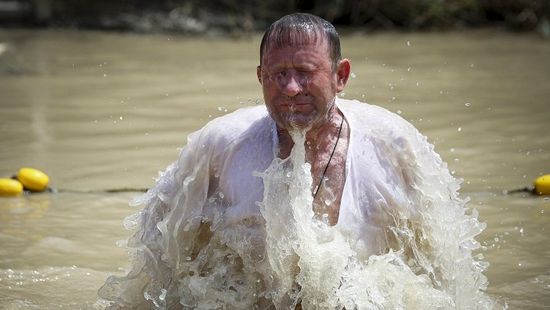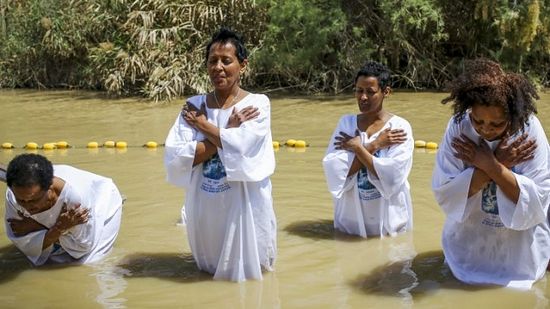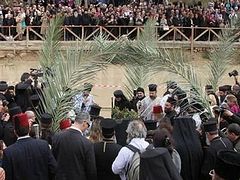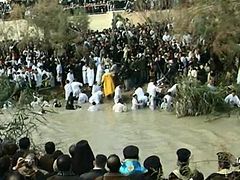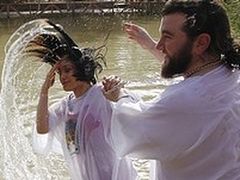Source: THE TIMES OF ISRAEL
The more than half a million people who visit the Jordan River site of Jesus’ baptism each year may be dunking in effluent water and subjecting themselves to serious health risks, an environmental group said.
The issue of protecting and improving the Jordan River, a site inextricably linked to Judaism and Christianity, is especially pertinent as Pope Francis releases a much-anticipated document on the environment on Thursday called “Laudato Si'” or “Praised Be.”
The document outlines the Catholic Church’s spiritual responsibility to protect the environment and is expected to have a wide impact on how religious organizations approach environmental issues.
Last week, the Jordanian-Palestinian-Israeli environmental activism group EcoPeace (formerly Friends of the Earth Middle East) released a 180-page master plan, providing a possible road map of concrete steps to clean the Jordan River. Used by Israeli, Jordanians and Palestinians alike, 96% of the Jordan River’s traditional flow has been diverted for agricultural and domestic purposes.
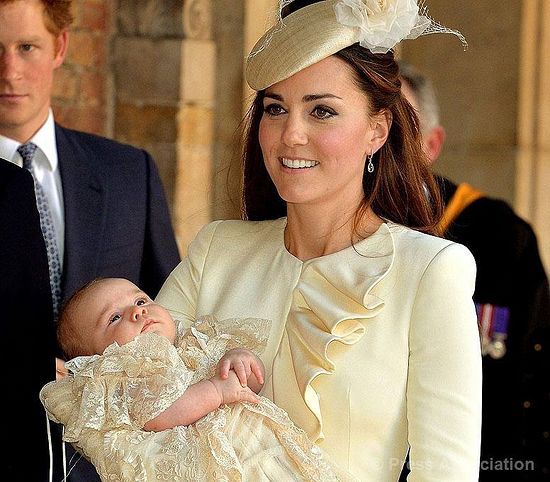 Prince George arrives for his October 2013 christening with his mother, the Duchess of Cambridge. (photo credit: Press Association/Courtesy of The British Monarchy Facebook page)
Prince George arrives for his October 2013 christening with his mother, the Duchess of Cambridge. (photo credit: Press Association/Courtesy of The British Monarchy Facebook page) At the same time, effluent and raw sewage have been dumped into the river basin, destroying the natural habitat. Although recent efforts have improved the water quality of the river and Israeli authorities constantly monitor the water levels for safety, the cleanliness of the water can be drastically improved.
The master plan takes a holistic approach towards conserving the environment, and one of the main goals is to improve the economic situation of the Jordan River Valley through tourism and tourism-related job creation.
But one major roadblock to increasing Christian tourism in the Jordan valley is that the water is such poor quality that it can make baptisms unpleasant, said EcoPeace Israeli director Gidon Bromberg.
“The water quality is anything but holy in nature,” he said. “The water quality for the full length of river south of Alumot [a dam below the Sea of Galilee] is a mixture of untreated and partly treated sewage, agricultural runoff, fish pond waste, and saline waters from springs to reduce salinity of Sea of Galilee… If in past the Jordan river was fast-flowing, overwhelmingly fresh water source, today the Jordan River hardly moves and has a very poor water quality.”
“The water at the baptism site is unhealthy,” added Nader Khateeb, the Palestinian director of EcoPeace. “It has so many potential health risks. We believe that the people who want to be baptized in that part of the river should be baptized in fresh healthy water.”
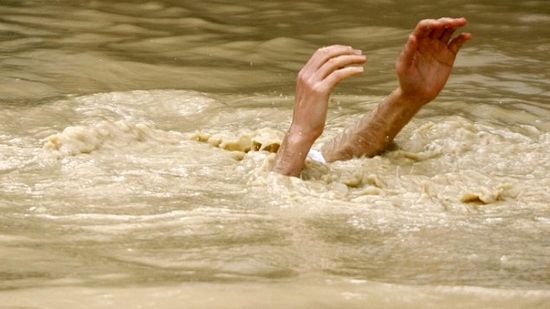 Orthodox Christian pilgrims dip in the Jordan River during a ceremony at the baptismal site Qasr el-Yahud on January 18, 2010, the Feast of the Epiphany. (Abir Sultan/Flash 90)
Orthodox Christian pilgrims dip in the Jordan River during a ceremony at the baptismal site Qasr el-Yahud on January 18, 2010, the Feast of the Epiphany. (Abir Sultan/Flash 90) The EcoPeace master plan outlines specific steps that can be taken immediately to improve the water quality of the Jordan, including proper sewage treatment systems on the Jordanian side and agricultural efficiency programs on the Palestinian side. EcoPeace also hopes to encourage the Israel Water Authority to increase the flow of fresh water coming out of the Sea of Galilee, which would dilute the pollutants. “We may not be able to return the Jordan to its original state, but we can create an economic engine in the Jordan River, not keep it a closed military zone,” said Khateeb.
Tourism is one way to create this economic engine, even in the current political situation. “There is a proposal for a trilateral working group on tourism to focus on bringing tourists to visit all sides of Jordan valley to promote it as a valley of peace, with a healthy Jordan River at its centerpiece,” said Bromberg. A polluted river will stunt the possible tourism growth, so improving water quality if of utmost importance.
To dip or not to dip?
One popular baptism site just south of the Kinneret, called Yardenit, attracts around half a million tourists a year, because this site is located north of the Alumot dam and does not suffer from issues with pollution. The site has 12 separate baptism pools with areas for mass baptism ceremonies and handicap accessible options.
The pollution issues arise further south. One hundred kilometers due south of Yardenit is the Qasr al Yahud baptism site on the Israeli-Palestinian side of the Jordan River, near Jericho. This is where many Christians believe, and the Israel Tourism Ministry markets, as the actual spot where John the Baptist baptized Jesus. There’s also a competing site across the river on the Jordanian side called Bethany Beyond the Jordan, where Jordanian historians and tourism officials claim Jesus was baptized on the Jordanian side.
According to an Environmental Ministry report from 2014, the fecal coliform count for the Qasr al Yahud site measured in November 2013 was 2,300 per 100 mL. The Health Ministry standards for swimming beaches is a maximum of 400 fecal coliform count per 100 mL, at which point a beach is closed to the public. This means at one point, the fecal coliform count was almost six times what is considered healthy to immerse.
Moving rivers are hard to measure because they are dynamic, so levels change dramatically from hour to hour. Six months prior, in May, the Environmental Ministry measured just 190 fecal coliform counts per 100 mL, which is within the limits. The higher levels in November could have been due to recent rains or any number of factors.
“Given that we know that there is a problem with sewage dumping, if we want an informed public then there should be live monitoring at the site,” said Bromberg. “If sewage is flowing down the river, they can close the site for an hour and then reopen.”
Fecal coliform itself is not dangerous, but it is measured because it is often an indicator of the presence of raw sewage and more harmful bacteria.
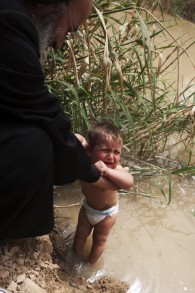 A child is baptized on Orthodox Easter at the Qasr-al-Yahud site on April 14, 2009. (Matanya Tausig/Flash 90)
A child is baptized on Orthodox Easter at the Qasr-al-Yahud site on April 14, 2009. (Matanya Tausig/Flash 90) “According to the reports from these groups, there is no raw sewage at the Qasr Al Yahud site,” said Health Ministry spokeswoman Einav Shimron. “The quality of the water in the streams feeding the Jordan has improved a lot, especially since the Kingdom of Jordan has stopped pouring the wastewater from cities into the river. There may be some wastewater coming from villages upstream up north, but it undergoes a natural purification and dilution process over the course of the distance.”
Bromberg said EcoPeace’s concern about the water quality stemmed from a desire to “bring back the integrity of the site,” even though the water has improved in recent years. “It could attract even more tourism, it’s in everyone’s interest [to continue improving the water quality],” he said. “We want to protect pilgrims and the ecology of the river at the same time.”
“At the baptism sites people come to immerse themselves, covering their whole face, perhaps drinking it, filling bottles of water to take home to baptize newly born babies,” Bromberg continued. This includes royal babies, as well, such as Britain’s Prince George, who was baptized in October 2013 with water taken from the Jordanian side of the river.
“There’s no warning sign, there’s a very small sign that is part of the instructions of entering the area with a small line that says this water is not potable.”
In July 2010, the Qasr al Yahud site was briefly closed due to health concerns, at which point Bromberg urged the Health Ministry to stop baptisms there altogether until the river could be sufficiently cleaned.
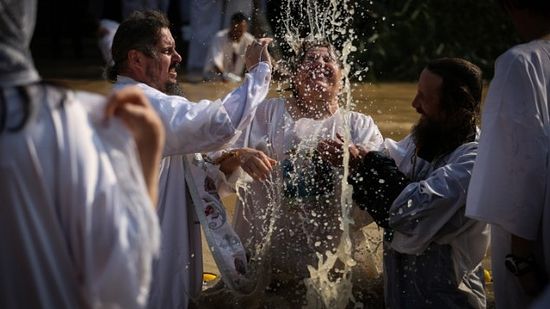 Orthodox Christian pilgrims take a dip in the Jordan river as part of a traditional Epiphany baptism ceremony at the site of Qasr al Yahud on January 18, 2015. (Hadas Parush/Flash90)
Orthodox Christian pilgrims take a dip in the Jordan river as part of a traditional Epiphany baptism ceremony at the site of Qasr al Yahud on January 18, 2015. (Hadas Parush/Flash90) Sa’ar Kfir, who has been the director of the Qasr al Yahud site since 2000, insists that the water is sufficiently clean for baptisms.
“We are required by the Ministry of Health to monitor the water, and the Ministry of Health comes every two weeks to monitor the levels of the water,” said Kfir, who works for the army’s Civil Administration.
“There are floods in the winter, and in these situations it could be that the water quality goes down and it’s not possible to baptize there, but this is monitored by the Ministry of Health.” He added that when that happens, the swift and strong water current makes it dangerous to enter the river as well, another reason the site may close.
“The water is safe for entering but not for drinking,” Kfir said. “There’s a sign that it’s not for drinking, but every tourist who comes here can clearly see that it’s clearly not for drinking.”
Israel Water Authority spokesman Uri Schor said the authority “places great importance on rehabilitating the southern Jordan River.” The Water Authority opened the Bitanya Sewage Treatment Plant in March of this year, which replaced an aging sewage treatment plant that was dumping effluents into the Jordan. The Bitanya plant will treat all of the sewage from Tiberias, meaning Israel is no longer dumping raw sewage into the Jordan. The Water Authority is also working on programs that will divert fish pond run off into water for agricultural use, Schor said.
One More River to Cross
Last year, Qasr al Yahud hosted 464,000 visitors, according to the Army’s Civil Administration, which administers the site along with the Nature and Parks Authority, because the site is located in an Israeli-controlled part of the West Bank. The Jordanian side across the river hosted 90,000 visitors in 2013. During his 2014 visit to the Middle East, Pope Francis visited the Bethany Beyond the Jordan site, where he met with refugees and disabled youth.
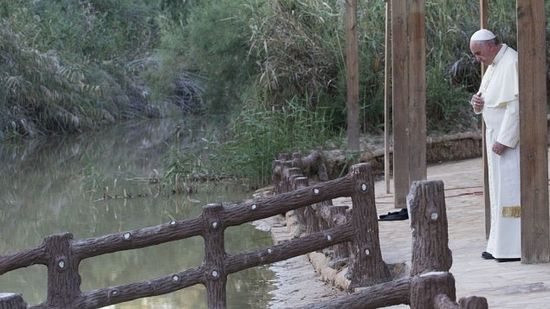 Pope Francis prays at Bethany Beyond the Jordan on Saturday, May 24, 2014, the first day of a three-day trip to the Middle East. (AP/Andrew Medichini)
Pope Francis prays at Bethany Beyond the Jordan on Saturday, May 24, 2014, the first day of a three-day trip to the Middle East. (AP/Andrew Medichini) The Qasr al Yahud site opened to the public in 2011 after a NIS 7 million ($1.82 million) investment from the Tourism Ministry and the Army’s Civil Administration. Previously, visitors had to coordinate their visit to the site with the army’s Civil Administration, which is responsible for the area since it is located in Area C of the West Bank. Now there is no coordination necessary, and the site is open every day of the year except Yom Kippur.
Increasing tourism would put additional grassroots pressure on the three countries to have a clean river for baptisms, Bromberg said. “There are potentially millions, perhaps tens of millions of Christian pilgrims that would want to be baptized at site where Jesus was baptized,” he said. “In Christianity, this water itself is holy.”
Christian tourism is important for the economy of the region because it already brings enormous amounts of money to the area, and has the potential to bring much more. In Israel, Christian tourists accounted for 60% of all incoming tourism, about 2.1 million visitors in 2013.
According to the Israeli Tourism Ministry, approximately 1 million Christians say the purpose of their visit is a pilgrimage, which would likely include a visit to the Jordan River. Israel reaps about NIS 19 billion in revenue ($5 billion) from all incoming tourists. About 200,000 Israelis are employed in the tourism or tourism-related sectors, 6% of the entire workforce.
 Christian worshippers carry a cross towards the Church of the Holy Sepulcher, traditionally believed by many to be the site of the crucifixion of Jesus Christ, during the Good Friday procession in Jerusalem’s Old City, Friday, March 29, 2013. (AP Photo/Sebastian Scheiner)
Christian worshippers carry a cross towards the Church of the Holy Sepulcher, traditionally believed by many to be the site of the crucifixion of Jesus Christ, during the Good Friday procession in Jerusalem’s Old City, Friday, March 29, 2013. (AP Photo/Sebastian Scheiner) Improving tourism across the region could duplicate these results for Jordan and Palestine, EcoPeace believes. It’s also a short-term, tangible plan that can help Israelis, Jordanians and Palestinians get started on the long journey of cleaning the Jordan River.
Environmental activists recognize that cleaning the Jordan River is a long process that will take decades. But EcoPeace’s master plan outlines short-term steps that can be undertaken immediately for maximum affect.
There’s a long way to go, but the Jordan River is already on its way to becoming cleaner than it has been in the past 50 years. Finding an economic impetuous to continue in that direction is the best hope for everyone in the Jordan River Valley, tourists, Christians, farmers and residents alike.
“All of the short-term interventions [in the master plan] deal with improving the water quality and a further release of fresh water,” said Bromberg.“ This means the water quality will improve dramatically, and that on its own will attract tourism.”

